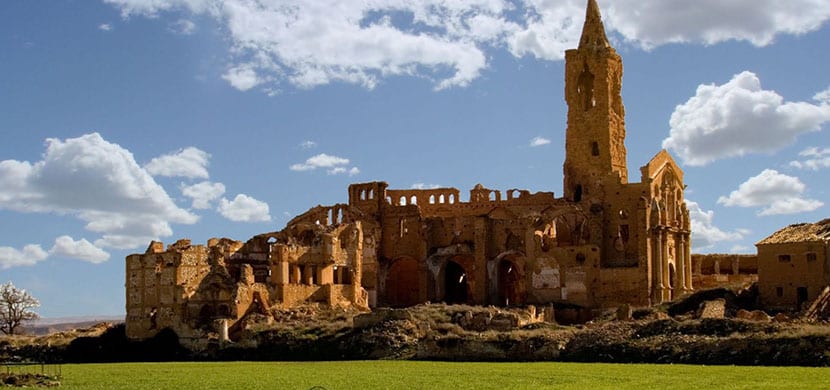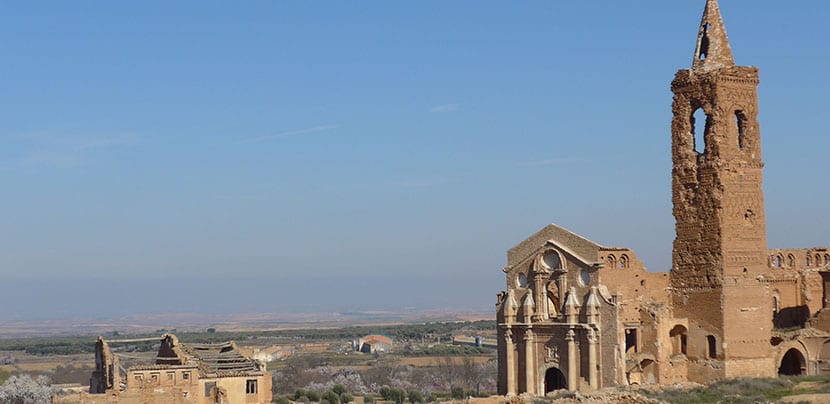
belchite It is less than 50 kilometers from the capital of Zaragoza and is a Historic place because it was one of the cruelest scenarios of the Spanish Civil War. Today there is a new city but the ruins of the original city, the one that witnessed a cruel and bloody battle, are still standing and can be visited.
According to the report "Habits and Trends in Spanish Tourism 2018", prepared by Atrápalo, Belchite is today among the ideal destinations in the country since its offer brings together cultural, historical and sports activities and also offers us the possibility of walking through a ghost town.
belchite

Recently a new idea was raised about the origin of the city, relating it to the ancient and celtiberian Belgium which the Romans later arrived at. Was the king Alfonso I of Aragon the one who conquered it from the Arabs at the beginning of 1100. He gave the lands to the criminals and criminals, forgiving them all the penalties for them to repopulate the place and make an appearance in an area that was still dangerous.

Over the centuries the area was populated, Christians, Moors, Jews, until in the 30s of the twentieth century the population was around 3 thousand inhabitants. For those years the PSOE had the mayor's office and when the coup against the republican government takes place, which unleashes the Civil War, the area is convulsed.
The Falangists and the Civil Guard travel through all the towns lowering the governments and arresting the most important left-wing people committing many shootings. It was the fate of the family of the mayor of Belchite after his own suicide, but at the same time teachers, workers, and peasants were killed.
It is between the end of August and the beginning of September that the Battle of Belchite, within the framework of the capture of Zaragoza. The damage in the town was tremendous and Franco decided not to rebuild the town so that Spain could always have in view an example of what he called "red barbarism." Everything remained as it was and a new villa, the New Belchite that was inaugurated in 1954 with the presence of the dictator.
Things to do in Belchite

The first thing, of course, is visit the Old Town. After passing the Arco de la Villa, in a baroque style, you can walk an hour and a half through the streets of this sector that includes two churches, San Martín de Tours and San Agustín, the Mudejar-style Clock Tower and also listen the story of that Battle of Belchite from the mouth of his descendants. The great thing is that the tour can be done in the evening and with the shadows of this time of day it has more drama. The visit is quite sensitive and is called "Traces of the Civil War".

You will see the remains of trenches, underground galleries, an old airfield, defensive posts and refugee camps. The tour allows you to go back in time to that summer of 1937 when Belchite burned in hell for two weeks, leaving 5 dead and a town devastated.
Both in the Old Town and in the surroundings there are traces of that battle and if you visit other municipalities such as Plenas, Codo, Azuara or Fuendetodos you will also be able to see traces of history.

But the truth is that Belchite has a history before the 30s so it also proposes tours to learn about its medieval legacy. During the day you can focus on this part of his life in which three cultures are reflected, the Christian, the Jewish and the Moorish. His traces have remained in the buildings but also in the gastronomy.
As the afternoon falls and before the night visit on the Battle of Belchite you will hear stories of bloody evildoers that some of them lived here, remember that Alfonso I had given them the green light for that, and even some other ghost story.

If you don't have time to visit all the destinations around you, you can choose sourceall since here there is an engraving workshop that uses the same techniques that Francisco de Goya used. So over here the goyesco tour It is not to be missed because it also includes the birthplace of the distinguished Spanish painter.

Today the Engraving Museum works here and you will see original works.
Eat and drink in Belchite

The area has one of the largest olive groves in Aragon so it is a good place to taste olive oil and see how the oil with the denomination of origin of the area is produced. If you go to the Alfonso Mill, for example, you can do the guided tour. On the one hand olive groves but on the other there are also arid areas, rugged steppes and the occasional fertile plain between which you peek ruins from roman times. Just go to your tourist office to get a map of roads and trails to go.
Wine has also been a Belchite classic for centuries. The wineries open their doors, for example the Bodega Tempore, in Lécera, which allows you to taste local wines and do some shopping. And what better than a piece of cheese to accompany a glass of wine so do not leave the region without trying the artisan cheeses.
Practical information to consider

Hours of the Old Town of Belchite (until March 25):
- Day visit: every day from 12 to 4 pm.
- Night visit: Friday and Saturday at 8 pm.
Special Easter hours:
- Between 29/3 and 1/4: Daytime visits are at 11 am, 12 pm, 1 pm, 4 pm, 5 pm, 6 pm and 7 pm.
- Between 29/3 and 31/3 the night visit will be at 10 pm.
Spring hours (between 4/4 and 17/6):
- Daytime visit: every day at 12 and 4 pm.
- Night visit Friday, Saturday and Sunday at 6 pm.
On 2/2 the hours will be at 12 and 4 pm and on 3/4 it will be closed for local holidays.
Information about tickets:
You can visit the Belchite website and do the Buy online. There you can choose the Guided visit to Pueblo Nuevo, night visit to the Old Town, the daytime visit to the same site or the visit to the Ethnological Museum or Combined ticket Pueblo Viejo day + Night. This ticket costs 12 euros. the night visit alone costs 10 euros so the combined ticket is always convenient.
So, now that we are getting closer to Easter and its days off, how about going to Zaragoza and getting to know Belchite?
In a very summarized way, I will say that the first to raze and commit outrages in Belchite were the Republican Army and the International Brigades, besieging and annihilating all the inhabitants, including women and children who were cruelly besieged and murdered. Once the Republican army settled in the town, it was the National Army that counterattacked and recovered the town for the National Side definitively.